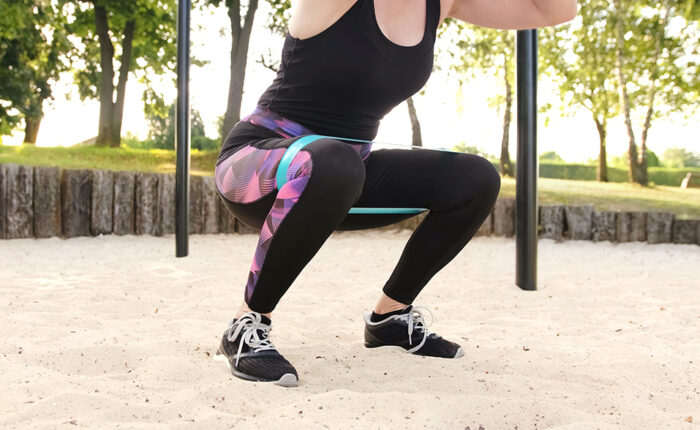The knees are essential joints in the fundamental role of movement and stability for your body. They’re made up of a variety of bones, ligaments, tendons and cartilage. They help in essential daily activities like walking, running, jumping and squatting. However, despite their importance, knees can be susceptible to injury and pain. Knee pain affects almost 65% of adolescents and adults each year. It is a common complaint and can have a significant impact on your ability to do daily activities and your quality of life. Knee pain when you squat can be common, but it is also often avoidable.
Why do I have knee pain when squatting?
Your body is designed to be able to squat without having knee pain. It could be possible your knee pain is due to a bad squatting technique. If fixing your technique doesn’t help your pain, you could be dealing with an underlying condition. Knee pain when squatting could be due to:
- Weak glutes — Weak glute muscles can contribute to hip instability and alignment during squatting. This causes an increased pressure on your knees. Weak glute strength can be common and can also cause you to overcompensate with your movements. This can result in knee pain and dysfunction.
- Knee bursitis — Knee bursitis is caused by inflammation of the bursae in the knee joint. The bursae are small, fluid-filled sacs that help cushion and lubricate joints. Knee bursitis can happen as a complication of knee arthritis and is common in people ages 40 to 60. Squatting can make bursitis symptoms worse, causing pain, swelling and tenderness around the knee because of an increase in pressure and friction.
- Patellofemoral pain syndrome — Patellofemoral pain syndrome, or runner’s knee, is caused by irritation of the cartilage under the kneecap. It’s the most common form of knee pain and can affect up to 23% of the general population and up to 29% of adolescents. Squatting can cause anterior knee pain, grinding sensations and inflammation, especially when you bend your knee.
- Tendinitis — A common condition caused by overuse or injury, tendinitis is inflammation of the tendons that attach muscles to the knee. These inflamed tendons, like the patellar tendon and hamstring tendon, can cause sharp knee pain or burning sensation during squatting.
- Iliotibial band syndrome — The iliotibial (IT) band is a thick band of tissue running along the outside of your thigh. If it becomes tight or inflamed, it can cause knee pain when you squat. Increased tension on the IT band can cause friction and irritation around your knee joint. It can affect up to 25% of adults and is responsible for about 12% of running injuries.
- Knee arthritis — Knee arthritis is the most common form of osteoarthritis, affecting approximately 46% of people in their lifetime. It is caused by the degeneration of cartilage in the joints and can cause chronic pain and stiffness. Arthritis can cause inflammation, swelling and a decreased range of motion. It can cause sharp pain and make symptoms worse when you squat. You may also notice snapping or popping noises when you move your knee.
- Knee sprain — Your knee can be sprained when you stretch or tear one or more of the ligaments that help support your knee joint. This common knee injury causes instability and pain. Squatting can make a knee sprain worse, causing you increased discomfort and reduced knee movement.
- Cartilage tear — A common culprit behind sharp knee pain is a torn meniscus, affecting approximately 1 million Americans every year. The meniscus is a C-shaped piece of cartilage that cushions your knee joint between your shinbone and thighbone. It can become torn due to a forceful twist or rotation of the knee and cause a sudden, sharp pain. Squatting can aggravate a meniscus tear, causing you pain. You may also experience a clicking sound or locking sensation in your knee.
How to squat correctly to help prevent knee pain when squatting
You may have heard that squatting is bad for your knees, but that isn’t true. When you do a squat correctly, it can be good for you. However, it’s important to know how to do a squat with proper technique. It could help prevent pain in the future. The best technique to do a standing squat is:
- Stand with your knees hip width apart.
- Make sure your weight is spread evenly through your feet.
- Take a deep breath in, and as you breathe out, start to squat.
- Check your knee position so your knees are behind your toes and your knees stay apart.
- Keep your heels down to keep your weight spread evenly.
- Check your upper body position: Keep your head upright, spine in neutral, chest lifted, and your shoulders drawn back gently.
- Don’t squat down too far — never let your bottom drop lower than your knees.
- Hold the squat for two to three seconds.
- Inhale, tighten your abdominal muscles, clench your buttocks together, push down through your heels, and slowly come up to your starting position.
- Gradually increase your repetitions.
Treatments for knee pain when squatting
A lot of people can see improvement in managing their knee pain by using one or more of the following treatments:
- PRICE treatment — PRICE stands for protection, rest, ice, compression and elevation. It can be a great first step to help treat knee pain from squatting. You’ll want to help protect your knee from further injury by avoiding activities that make your pain worse. Rest your knee to give it time to heal. Apply cold packs to the affected knee to help reduce pain and inflammation. Use a compression wrap or knee brace to help provide support and reduce swelling around your knee joint. Make sure the compression or brace is snugly fitting, not too tight. Elevate your knee about your heart level whenever you can to help reduce swelling and promote circulation.
- Medication — Taking an over-the-counter (OTC) pain reliever or nonsteroidal anti-inflammatory (NSAID) can help reduce the pain and inflammation in your knee due to the squats or underlying condition irritated by the squats. It’s essential to take these as directed. Your doctor may prescribe stronger prescription pain medications if your pain is severe.
- Physical therapy — Physical therapy can be a beneficial treatment to help you find relief from pain caused by or felt during squatting. A personalized treatment plan can include strengthening and flexibility exercises as well as proper techniques to address underlying issues.
- Surgery — In more serious cases of severely torn ligaments, tendons, muscles or cartilage, surgery may be needed to help address the issue causing your knee pain when squatting. Physical therapy may be recommended as a part of your recovery routine.
Physical therapy treatments for knee pain when squatting
Physical therapy treatments can provide effective strategies to help manage and alleviate knee pain when squatting. Treatments that can help restore your mobility and improve your overall knee function include:
- Active Release Techniques® (ART) — ART is a specialized manual therapy technique where your physical therapist will apply targeted pressure to help release adhesions and tension in the soft tissue around your knee joint. As they palpate the affected muscles and tendons, they can feel for areas of restricted movement or scar tissue buildup. Using precise movements and varying pressure, your physical therapist will work to help break down adhesions and release tension. ART can help improve your mobility and reduce pain during squatting.
- Graston Technique® — The Graston Technique is another specialized manual therapy technique where a physical therapist uses specialized stainless steel tools to apply controlled pressure to the affected knee joint to find fascial restrictions or scar tissue. With precise strokes and angles, your physical therapist can break down the scar tissue and fascial restrictions. This technique can help promote tissue healing and improve your knee function.
- Functional rehabilitation — A functional rehabilitation program is designed to help you move at your peak level of potential. It melds agility and proprioceptive/kinesthetic training to help you return to pre-injury level and help reduce your risk of having the same injury again. It’s designed to help you rebuild your activity function from the ground up. It can help you learn proper posture, balance and movement in your everyday life and how to perform your squats better so you can do them without knee pain.
SOL Physical Therapy can help you address the underlying issue causing your knee pain when squatting
SOL Physical Therapy physical therapists are experts in the movement of the body and can help you discover the underlying cause of your knee pain when you squat. Starting with a comprehensive evaluation, once an issue is determined, one of our physical therapists can build a personalized treatment plan for you. Your customized plan will be designed to help:
- Reduce your pain.
- Improve your knee function.
- Increase your ability to do squats and other normal daily activities.
- Reduce your risk of future knee problems.
Call us or request an appointment today to find relief from knee pain when you squat.


